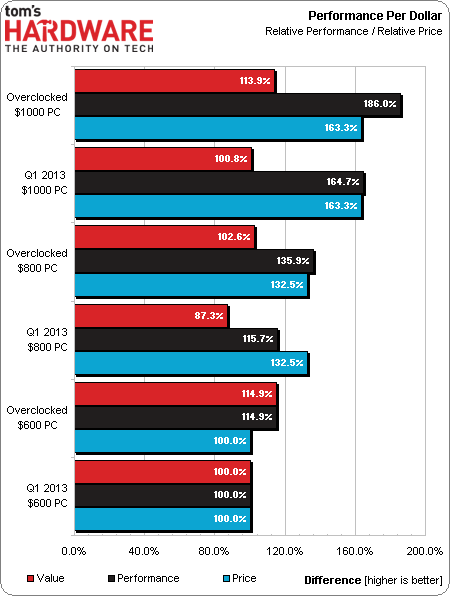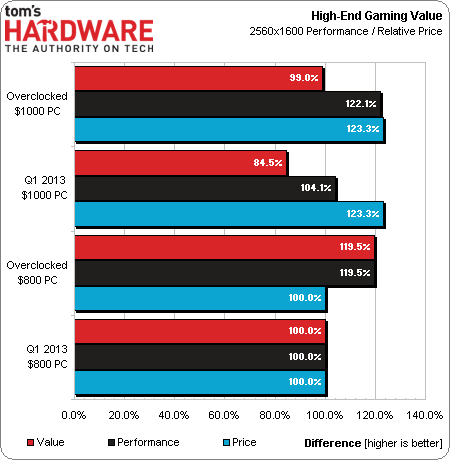System Builder Marathon, Q1 2013: System Value Compared
Where's The Value Sweet Spot?
Based on our past experience, the cheapest system doesn’t always prevail in this price-per-performance paradigm. We've even seen a $1,000 machine top the value standings in our past three System Builder Marathons. But those competitions were based on budgets between $500 and $2,000. This time around, we went in search of the best possible value and narrowed that range from $600 to $1,000. Don's $800 machine fills the middle spot where I've traditionally found the best value.
This time around, my $1,000 machine only tops the value chart when we make our comparison at stock clock rates. Unfortunately, I don't pick up enough performance from overclocking to maintain a lead. The most likely explanation is that the SSD in my system does plenty to boost baseline performance, but cannot be overclocked. So, its impact tapers off when we overclock. When it comes right down to tweaking, the $600 machine offers a value lead of 1%.
A lead that small won’t matter to anyone who wants to game at high resolutions, and the extra memory capacity available in both the $800 and $1,000 machines is probably more important in a real-world, multi-tasked environment, even if it has little impact on our benchmarks.
However, anyone in the market for a big monitor probably won't be shopping around for a $600 PC. Furthermore, anyone looking for a gaming PC priced at $600 should be willing to give up a little productivity-oriented performance in the interest of spending as much of the budget as possible on a competent CPU and GPU. Paul Henningsen deserves full credit for a win that breaks the mid-priced PC’s winning streak.
Anyone who can afford a big monitor probably expected to see the $800 and $1,000 machines, which coincidentally employ similar hardware, achieve similar performance, giving the less expensive build a better gaming value outcome. Really, though, that's only true if you're able to tolerate slower boot-up, shutdown, and level load times.
Paul's $600 machine wins the value contest by a small margin when it's overclocked, the $800 box becomes a far more compelling value proposition when you're gaming at high resolutions, and my $1,000 system becomes the best overall value among the three stock configurations. Aside from rejecting the notion of value superiority at $800, today's results don't get us any closer to finding a performance per dollar sweet spot. It now appears to be somewhere around $600 for PCs without SSDs and $1,000 for more enthusiast-oriented setups with solid-state storage, though there’s enough flexibility between all three builds to come up with an SSD-equipped $750 machine that could turn our findings upside-down.
With this many options available, we’ll leave it to you to decide whether the next System Builder Marathon should return to the broad budget ranges of our previous efforts, center around the $600 price point, center around the $1000 price point, or...?
Current page: Where's The Value Sweet Spot?
Prev Page Power Consumption And EfficiencyGet Tom's Hardware's best news and in-depth reviews, straight to your inbox.
-
plasmaj12345 thymanbearpigYou would think with an extra $200 you can get a noticeable difference in fps..Reply
The only real difference between the $800 and $1000 PC is that the $1000 has an SSD. They both have the same CPU, RAM, and GPU. Gaming should be about the same on both.
-
saxplayingcompnerd @thymanbearpig They use the same GPU, most games are GPU bottle-necked. That's how they get nearly the same FPS.Reply -
mayankleoboy1 Something i posted last quarter too :Reply
Why would all the machines have same percent emphasis on games and productivity apps ? Why would a $600 gaming PC be evaluated similarly to a $800 enthusiast PC ? The percentwise distribution of each metric should be based on what usage the build was meant for.
Something like : games, apps, storage.
$600 build : 85%, 15% . (cheapest, best gaming. Very few apps. Doesnt need fast storage. )
$800 build : 55%, 35%, 10% (slightly better games over apps. Great apps. fast storage for OS + apps OR games)
$1000 build. : 42.5%, 42.5%, 15% (equally good games and apps. fast storage should be plenty for OS+apps+games) -
Crashman ankit0x1still waiting for 2000$ buildHow about building up the $1000 machine into a dual-GPU added-storage $1600 PC?Reply -
mayankleoboy1 can we have a chart of the combined totals of :Reply
1) FPS in games
2)time taken in apps
for each build?
so that we may draw our own conclusions from the data? I am not entirely satisfied with the conclusions you have drawn. -
Crashman mayankleoboy1can we have a chart of the combined totals of :1) FPS in games2)time taken in appsfor each build?so that we may draw our own conclusions from the data? I am not entirely satisfied with the conclusions you have drawn.Percentages are just as accurate, you'll find those on Page 13 along with power numbers.Reply
-
bdizzle11 For next SBM how about a $800, $1200, $1600. A little bit higher but more spread. I think that would better determine the sweet spot...Reply -
atomicWAR Honestly i would like to see an up-graders marathon. With price points of 600, 800, 1000, 1300, 1600, 2000 covered all using the same case, CD/dvd, and mech HDD (not included in cost). Those are the most common carry over parts besides my water-cooling that carries over build to build. I believe it would be a very useful and realistic application of funds many of your readers could relate to.Reply



